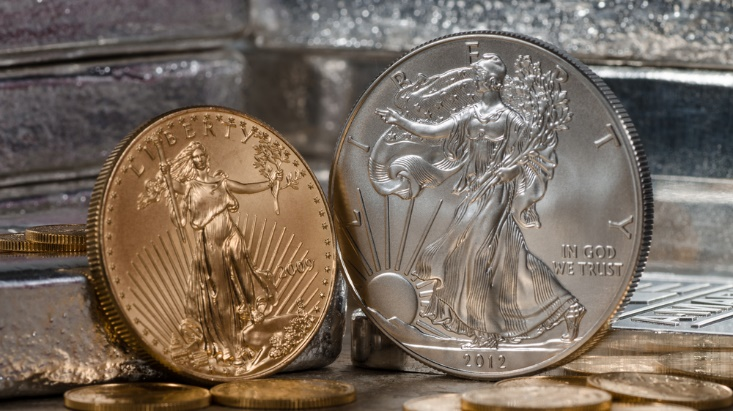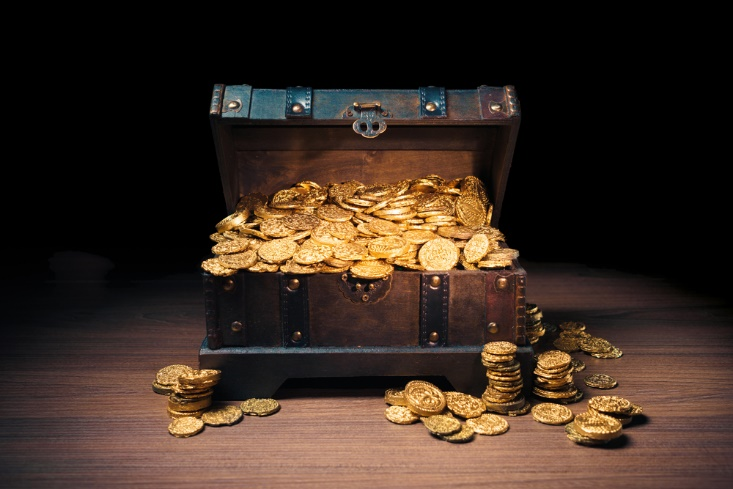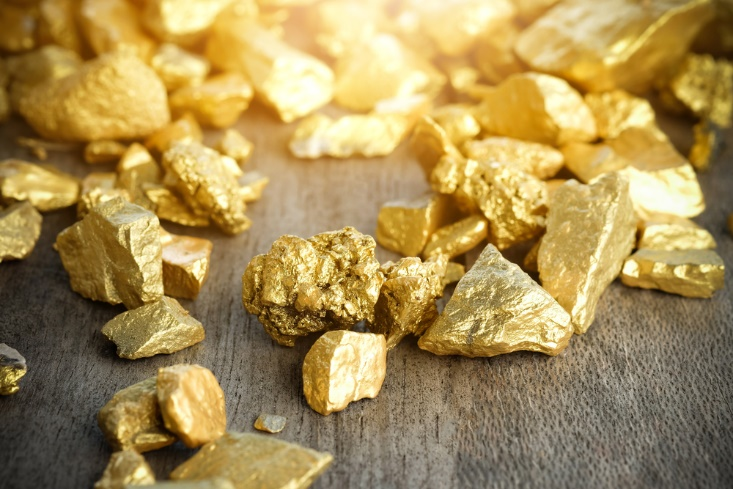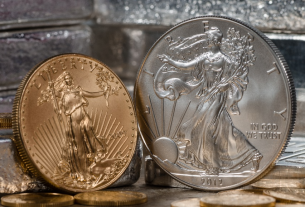Due to recent volatility in stock and bond markets, many investors have turned their attention to precious metals as a hedge against that volatility. With memories of the 2008 financial crisis and its aftermath still fresh in many investors’ minds, their thoughts naturally turn to gold and silver, two assets that protected investors’ assets during the crisis. While stock markets lost over 50% of their value during the crisis, gold increased in value by over 25% and continued to gain value over the next few years.
Precious metals have always been sought after by investors, and particularly during financial downturns. Their ability to keep gaining value while financial markets come crashing down around them is unparalleled. And while there are numerous precious metals to invest in, gold and silver stand head and shoulders above the rest in their ability to offer investors solid returns during tough financial times.
As with any other asset, investing in gold or silver can lead to both gains and losses, especially in the short term. But for investors who are looking for long-term wealth appreciation and asset protection, precious metals investing is tough to beat. So is it better to invest in gold or silver? Read on to find out.
Consider Silver vs. Gold Price and Affordability

One of the first things that you’ll notice about silver and gold is the difference in their price. At around $15 per ounce for silver and over $1,400 per ounce for gold, there’s quite a disparity there. The price of gold has always been more expensive than silver throughout history as its supply is less than silver, and demand for gold is greater.
Silver is often referred to as “poor man’s gold,” as it allows those without a lot of money or who are just starting out their investing to invest in precious metals without the sometimes significant outlays required by investing in gold. A 20-coin roll of one-ounce silver coins will cost only a fraction of what a single one-ounce gold coin would.
Those who are dead set on investing in gold can purchase smaller gold coins such 1/4-ounce, 1/10-ounce, or 1/20-ounce coins, but they’ll often have to pay premiums of 25-75% to buy those coins. There is a use for those coins, but for investors just looking to benefit from intrinsic metal value they’re not the optimal choice.
For those investors who have saved and accumulated a significant amount of assets, gold can be a much better option than silver. With its high value per ounce and its high density, gold allows investors to store a huge amount of wealth in a very small footprint. A roll of one-ounce gold coins is worth nearly $30,000 and can be held in the palm of your hand. A similar value of silver coins would require multiple large boxes.
The price ratio between silver and gold can fluctuate quite a bit. Sometimes, the silver price is more affordable than gold, and at other times gold is more affordable than silver. Savvy investors will pay attention to those trends and invest in gold and silver when either is more affordable.
The Volatility of Investing in Gold or Silver
While neither gold nor silver prices are as volatile as stock prices, there is a difference in volatility between the two. Gold and silver normally move in tandem, with silver rising or falling along with gold. That’s due to the fact that both metals are heavily demanded by investors looking for safe stores of wealth.
Silver’s greater use by industry, particularly today in manufacturing solar cells, leads to slightly greater price movements. And because of silver’s lower price, a 40 cent rise in silver’s price is a greater gain percentage-wise than a $20 rise in the gold price.
That greater volatility won’t normally make a difference to investors looking to hold silver in the long term. But it does mean that investors who know they’re going to take a distribution in the near future need to pay attention to price movements so that they can time their silver sales to take maximum advantage of silver’s price movements.
How to Store Your Precious Metals Investments

With any precious metals investment comes the need for storage. Whether you choose to buy physical coins and store them at your home, store them in a bank safe deposit box, or invest in gold and silver through a precious metals IRA and store your gold or silver with a custodian, you need to keep your precious metals safe from thieves. That’s an important aspect of precious metals investing that differs from investing in purely financial assets.
That storage, and any insurance you decide to purchase, adds an extra cost that can eat into your annual returns. Investors need to decide for themselves what level of storage and security they want to pay for. You can take the risk of keeping gold and silver at home without a safe, but if you’re robbed, your entire investment is for naught.
You can buy a safe and pay for insurance through your homeowner’s policy, but the upfront cost for a safe and the annual cost of insurance can add up to thousands of dollars over your period of ownership. If you choose to rent a safe deposit box from a bank, you’re limited as to when you can access your precious metals. And if the bank goes out of business, you might have to wait quite a while to get your investment back.
Finally, you can invest through a precious metals IRA and store your gold and silver with a custodian whose bread and butter is precious metals storage. Costs for storage and insurance are then minimized by being spread over all the different owners who store their assets with that custodian.
Remember too that gold is easier to store than silver since it is less bulky. That means that you’ll pay less in storage costs per square foot, although you’ll likely pay more insurance per square foot. However you decide to store your precious metals investments, you’ll want to make that decision before you make your investment so that you spare yourself any unwelcome surprises.
Think About the Demand for Both Gold and Silver
Gold’s primary demand is from the jewelry industry. Much of the jewelry demand comes from China and India, particularly the Indian wedding season. That jewelry isn’t owned so much as a form of ostentation but is rather held as a traditional form of gold as an investment.
Investor demand for gold coins and bars forms the next largest driver of demand for gold, and demand for coins and bars continues to grow every year. Given the numerous economic and geopolitical factors governing safe haven investment demand, it’s safe to say that investor demand for gold and silver will increase in the coming years.
For decades silver’s primary use aside from coinage was in the production of photographic film. Once film usage went by the wayside, industrial demand for silver plummeted. But the lowered prices that resulted provided an incentive to find new uses for the metal, such as a potential replacement for platinum in catalytic converters. The price drivers for silver in the future will come from a mixture of industrial demand and investment demand.
As most silver production today comes about as a byproduct of gold mining, silver supply has very often failed to meet demand in recent years. That means that silver recycling has been key to keeping supply and demand in balance. But increasing demand for silver in producing electronics, medical devices, etc. means that silver’s price will likely make significant gains in the future. And if silver-zinc car batteries become popular in electric cars then silver’s price could go through the roof.
Availability of Gold and Silver Investments
Gold and silver are abundant in the earth’s crust but, because of the vast amount of time and energy that it takes to identify gold and silver deposits and mine them profitably, most gold and silver won’t ever be mined. That means that the above-ground supply of both of those metals is relatively finite. With only small amounts of mined metal being added to above-ground stores each year, and increasing demand from investors and industry, prices of gold and silver are set to rise.
Mining continues to grow more expensive, so future demand for gold and silver will increasingly have to be met through recycling. Whether this means extracting gold and silver from junked old electronics or melting down old coins, these secondary sources of gold and silver will become more and more important in the coming years. And with continued melting down of gold and silver coins to gain access to their precious metal content, the prices of remaining coins held by investors will only rise further.
Whether you invest in a gold IRA or a silver IRA, the options available to you are numerous. The process of starting a gold or silver IRA isn’t difficult at all, and you can even roll over existing retirement savings into a new precious metals IRA. By investing in precious metals you gain the confidence of knowing that your wealth is protected in the form of physical assets that have stood the test of time and safeguarded investors for centuries.
If you’re mid-career and looking to hedge a portion of your investment portfolio or nearing retirement and looking to get most of your retirement assets into safe havens, the experts at Goldco can give you all the advice you need to get started in precious metals investing. Their experience in helping investors just like you get started in investing in gold and silver will give you the edge you need to achieve your investment goals.
This article was originally posted on Goldco.




